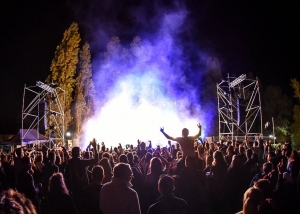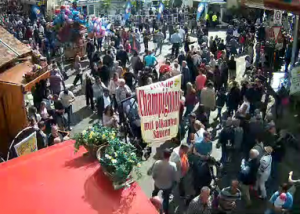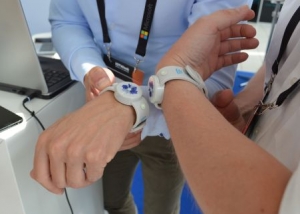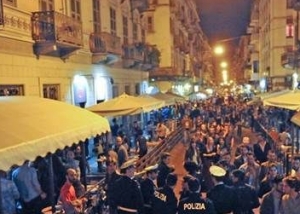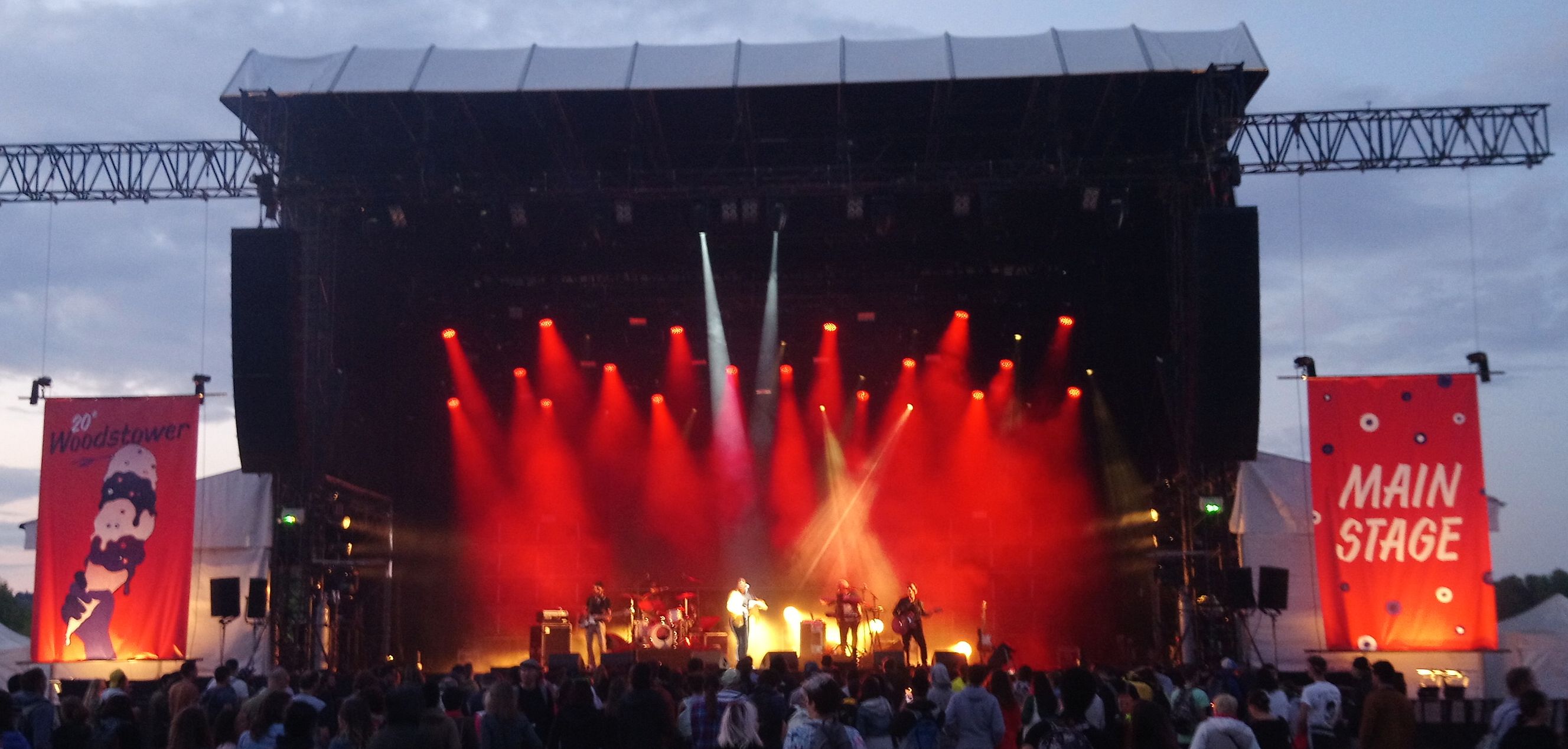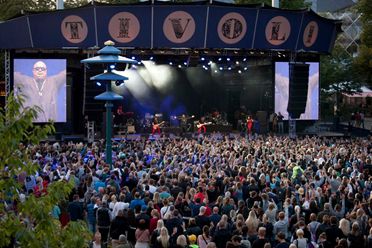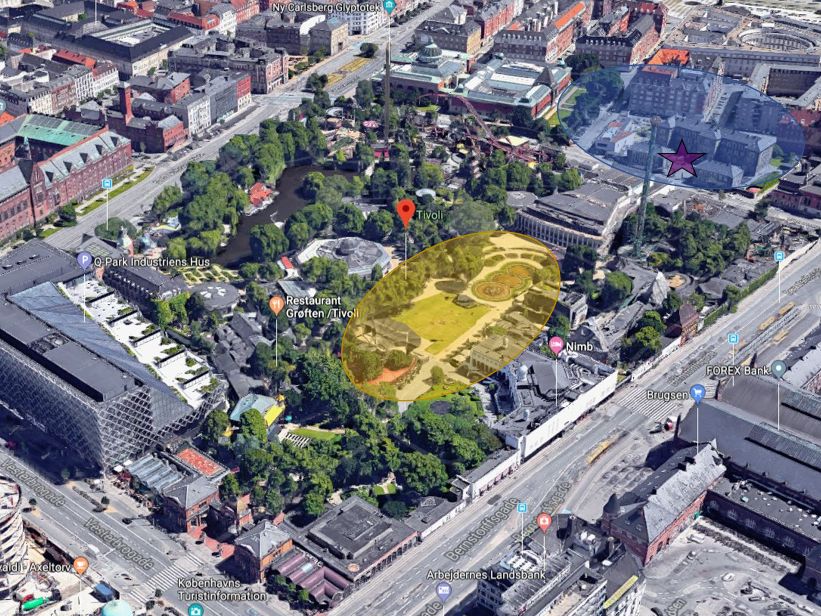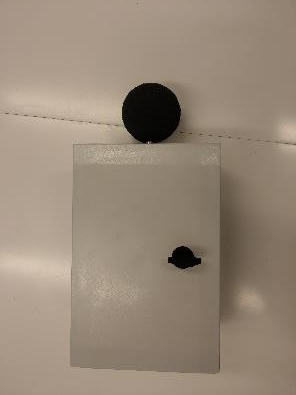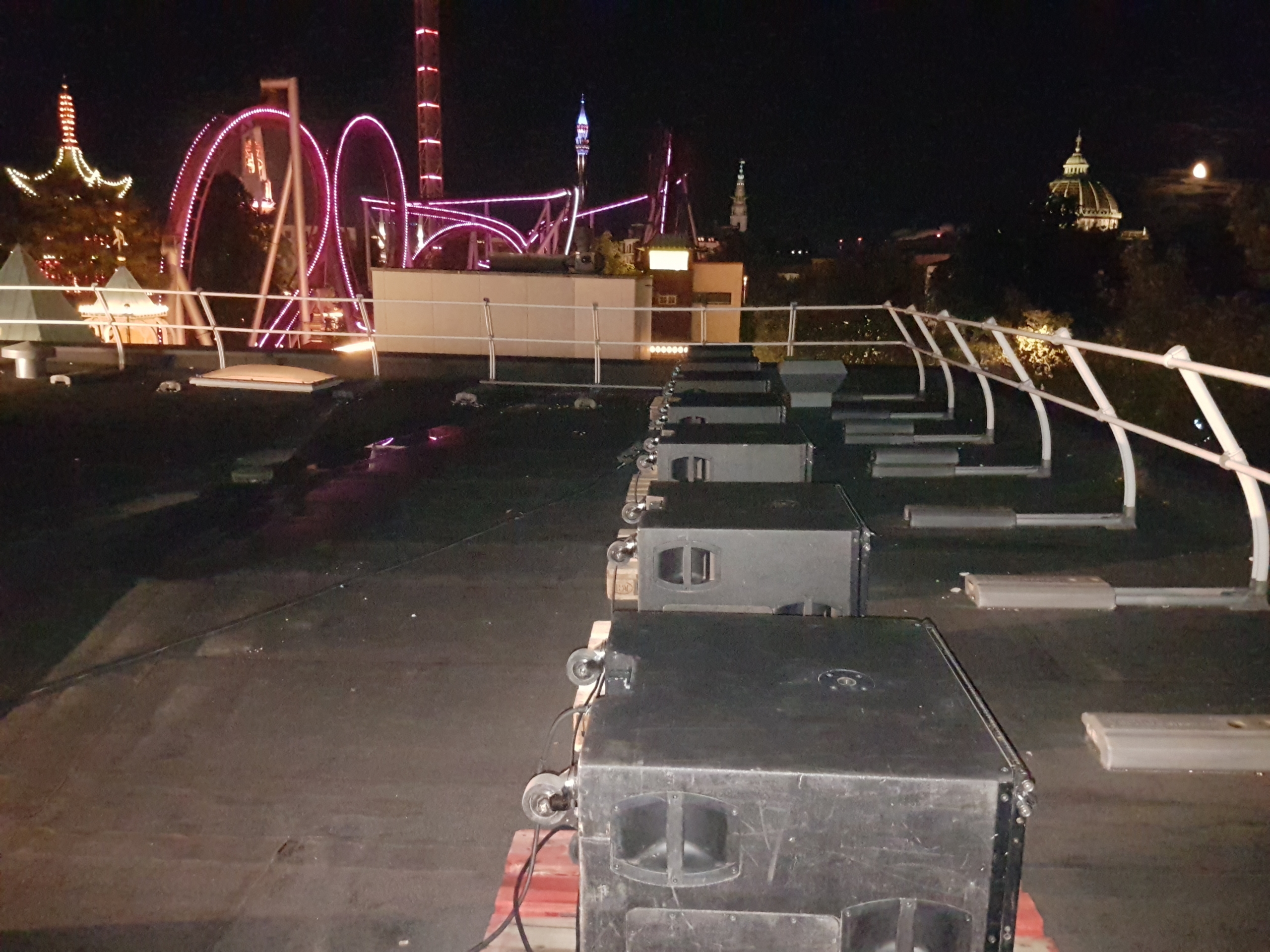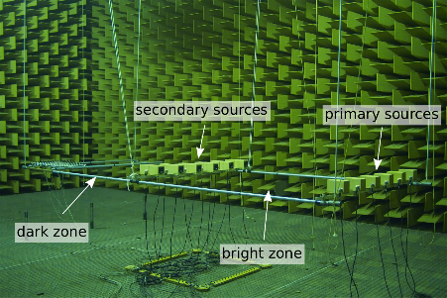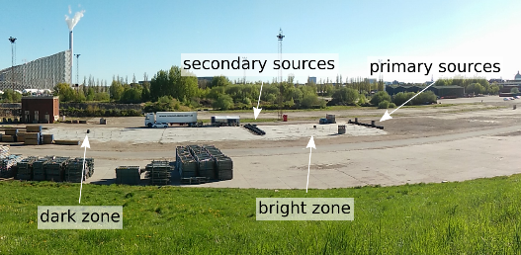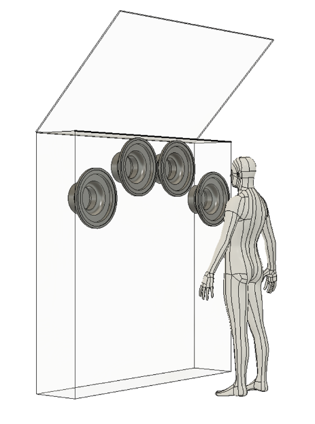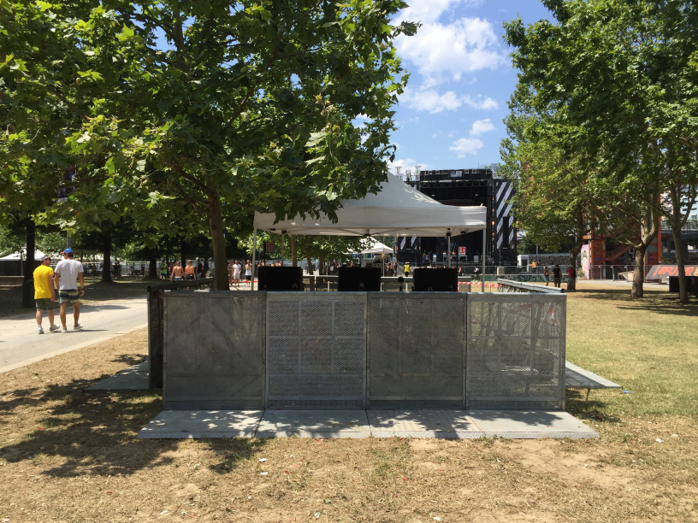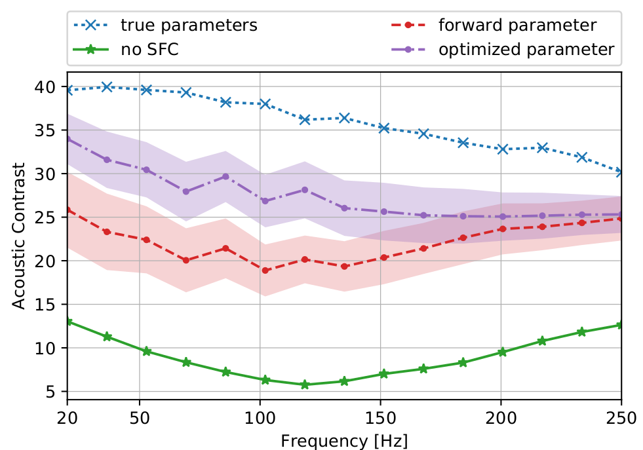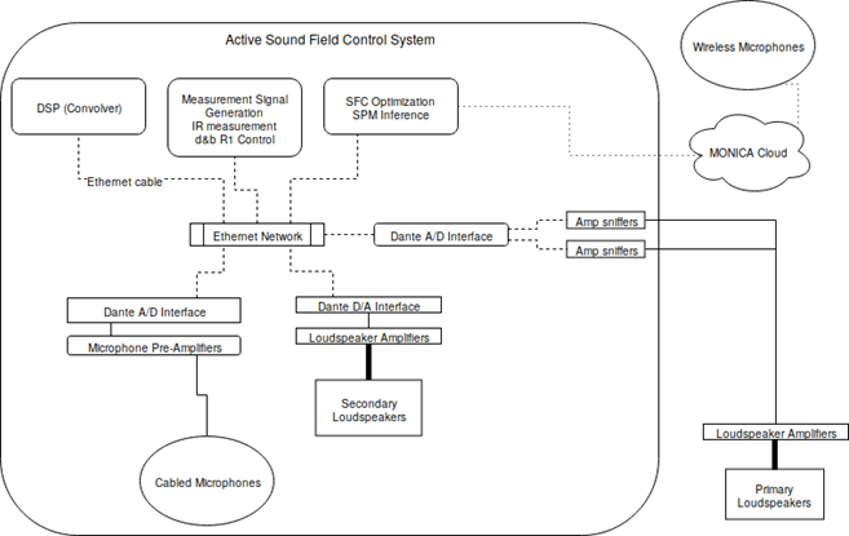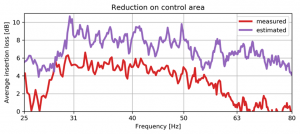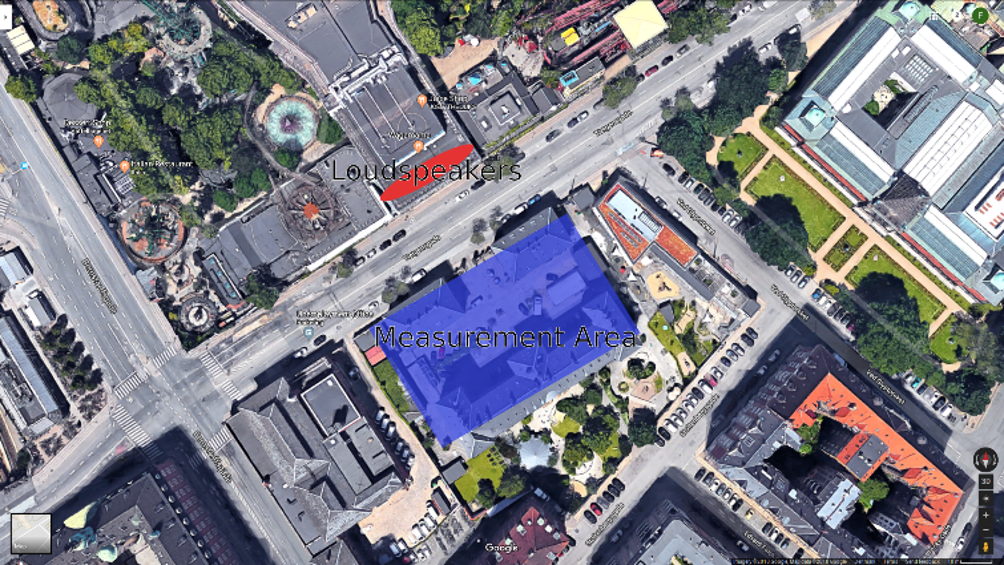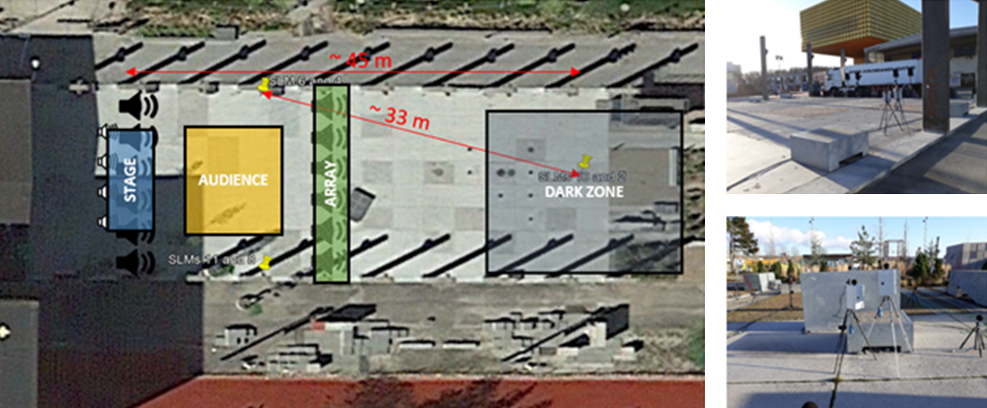Adaptive Sound Field Control
Improving visitor’s sound experience during musical events venue while at the same time reducing the noise annoyance for the neighbours seems to be a contradiction. But it is not.
The MONICA Adaptive Sound Field Control solution is an advanced sound control system that can impact the sound field outside the scene layout through the active and adaptive sound field control.
The system can provide an optimised sound field in the audience area (bright zone) while reducing the sound levels in neighbouring areas (dark zones) with up to 10dB.
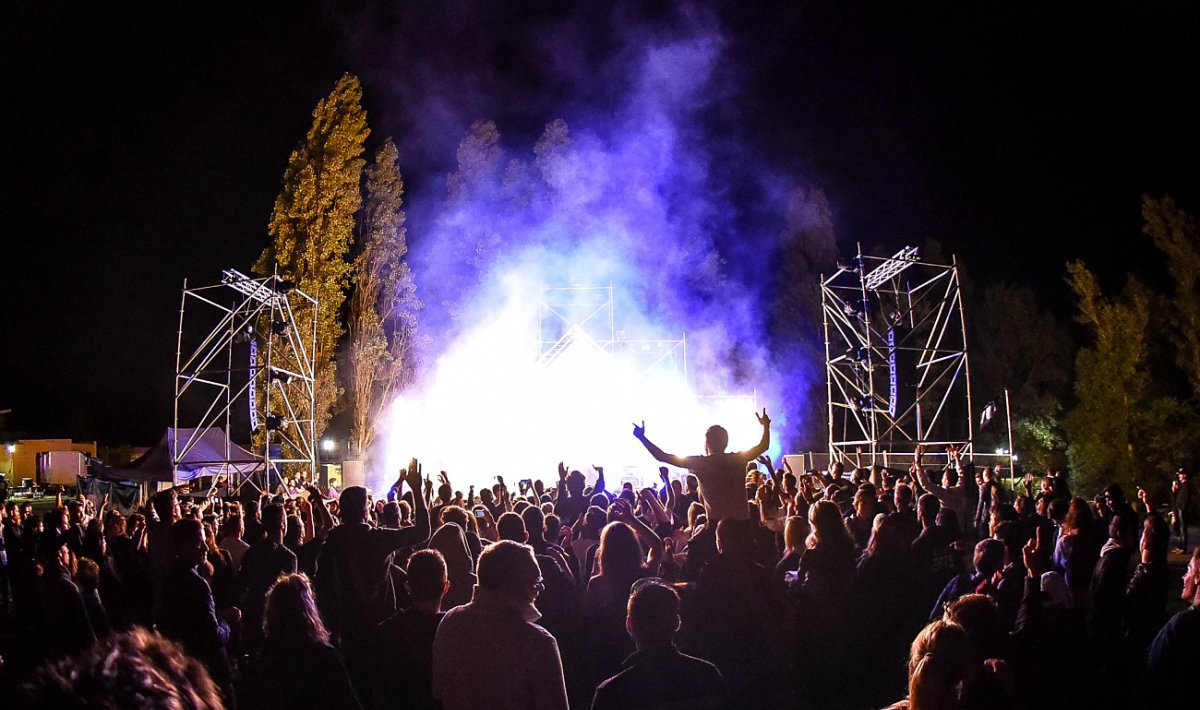
In other words, the music can be louder for a better concert experience at the front of the stage, whereas sound levels can be reduced outside the concert area for less annoyance. To this end, the sound levels are dynamically controlled adjusting for changes in weather or audience, which impacts the propagation of sound waves. The system can work in any kind of environment, openair or closed space or urban area.
Low frequencies (less than 100Hz) are the most critical frequencies in the noise. Sound waves at these frequencies are less attenuated in the air, less prone to reflections from boundaries, and less impacted by the buildings. The MONICA Adaptive Sound Field Control solution actually offers a better reduction of these low-frequency components in the music sound field. Consequently, concerts, festivals with rhythmic music (rock, techno, jazz, etc.) with a high content of low-frequency components are the most likely beneficiaries of the MONICA Adaptive Sound Field Control solution.
Overview
| Application areas | Type of locations | Main features |
|---|---|---|
|
|
|
Challenges, Features and Benefits
Urban spaces are growing fast and cities are becoming denser and denser, so the issue of the perception of sound emissions outside a venue is increasingly challenging. Organisers of concerts want to give their performers and audiences the best music experience but they also wish to comply with local regulations on environmental sound exposure.
This produces a two-sided dilemma when you talk about outdoor concerts in residential areas: Since high sound pressure levels are necessary for optimal concert sound, there is a risk of the audience becoming disappointed and artists turning down invitations to perform if regulations say you have to turn down the volume. And even if you comply with the regulations, you might still have to deal with residents living next to the venue who complain about the noise coming from the concerts, and that it is affecting their quality of life.
A typical example, where the MONICA Adaptive Sound Field Control solution can make a difference, is the Tivoli Gardens Entertainment Park in Copenhagen. Tivoli organises rock concerts every Friday during the summer season and is struggling with emissions of noise to the neighbourhood, in particular from the outdoor music performances as well as general noise from the amusement park. The neighbours are regularly filing complaints about the sound levels with the Municipality resulting in caps being put on the total sound levels that can be emitted. The capping means that international artists have refused to play at the outdoor stage at reduced audio levels. Also, the music audience complains about low sound volume during concerts.
The working principle of the MONICA Adaptive Sound Field Control solution is to install extra loudspeakers around the concert venue and optimize the sound radiation from them in such a way, that the sum of sound pressures directly from the performers (primary sources) and from the additional loudspeakers (secondary sources) add together in any observation point in the dark zone and thereby effectively reduces the total sound pressure level in the that an observation point.
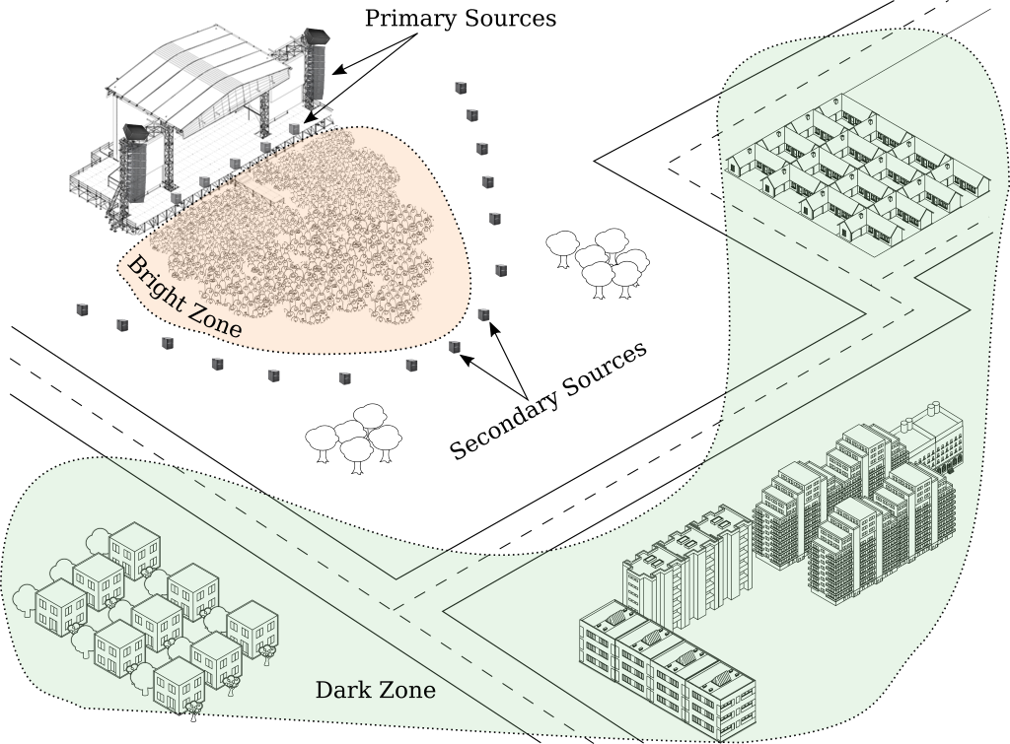
Basic principle of the MONICA Adaptive Sound Field Control solution
The solution is tailored to the precise needs of the client. It can be used in any type of open-air, gated and non-gated event. However, due to the complexity and magnitude of the installation, it is at the moment not suitable for short term deployment (e.g. for a single concert). The most likely targets are recurrent events (monthly or seasonal) or in permanent installations.
The MONICA Adaptive Sound Field Control solution provides the following features that help concert organisers cope with noise problems:
Sound level reduction: Overall, the ASFC depends on additional loudspeakers pointing towards the area where noise reduction is needed. This part is integrated with the venue’s overall sound (PA) system. The ASFC enables a high sound pressure level in the bright zone relative to the sound pressure level in the dark zone thereby creating the impact of sound level reductions. Moreover, the additional loudspeakers to control the sound in the dark zone do not negatively impact the sound experience in the audience area, the bright zone. The software for sound field optimization algorithm and sound propagation model is configured and tuned specifically for each venue.
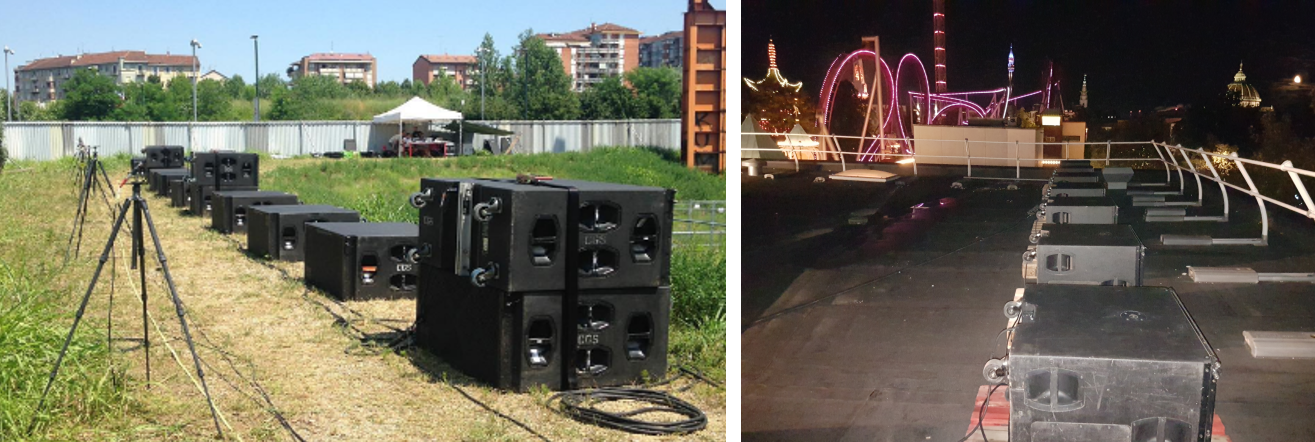
Secondary sources consist of large loudspeaker arrays pointing towards the dark zone. Examples from Kappa FuturFestival 2018 (left) and Tivoli Fredagsrock 2018 (right)
Adaptable sound field control: Two important prerequisites for the ASFC system to perform well in a practical situation are: 1) obtaining an accurate sound propagation model for the venue and 2) providing a suitable controlling signal through the secondary sources (loudspeakers).
- The propagation model can be obtained using various environmental sensors and microphones in and around the concert area. Sensors for wind speed, humidity and temperature provide data for the propagation models and “heat maps” for the venue areas.
- The control signal is obtained by converting the entire PA system output to a control signal for the secondary sources. The control signals have been modified in order for the desired effect to take place in each observation point in the dark zone. The modification takes place in fast computer algorithms based on so-called “forward models” that models the sound propagation through atmospheric air from the secondary loudspeakers to the observation point in the dark zone. The forward model is continuously updated using input from the environmental sensors in order to adapt to changes in atmospheric/weather conditions during the concert.
Sound Level Meters: The Sound Level Meters (SLM) should be type-approved, accredited and calibrated Sound Level Meters, which measures correctly under changing environmental conditions like temperature and humidity. They are enabled for use in the IoT networks and are easy to install and move around the convert venues as necessary in order to provide proper input for the adaptive algorithms. Sound level data needs to be collected in real-time and send directly to the ASFC with minimum latency.
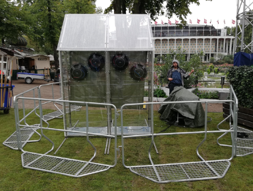
Quite Zone, Tivoli 2018
Quiet Zone: A Quiet Zone is a noise barrier that allows staff on the field to have a small physical space where they can speak without the overwhelming sound from the concert performance. The Quiet Zone principle is to make use of active elements (ASFC) to cancel out low frequencies and passive elements (sound blocking screens) to block higher frequencies using a passive noise barrier. The aim is to obtain the highest possible attenuation of sound level across the entire listening spectrum without disturbing the sound field from the primary sources.
The Quiet Zone system might be installed independent from the ASFC – but will work best together with it.
The MONICA Adaptive Sound Field Control solution can be seamlessly integrated with sensors and actuators using the MONICA Crowd and Capacity Monitoring solutions and the MONICA Cloud in the MONICA Crowd Management and Communication solution. The total solution can have a benefit in monitoring and managing the sound before and during a performance. The main feature of the MONICA Adaptive Sound Field Control solution is to provide an IoT solution with closed-loop feedback that addresses noise challenges during concerts and musical events.
To this end, the MONICA Adaptive Sound Field Control solution offers a multitude of innovative benefits related to the execution of open-air music performances in the public space.
Benefits for the performers and organisers:
- The sound experience can be optimised with respect to both the performers and the concert audience in terms of loudness, directionality, and quality. At the same time, the ASFC system can perform dynamic adjustment of the secondary source loudspeakers so that neighbours of the concert venue can enjoy up to 10dB attenuating of the sound levels in their neighbourhood, where it is unwanted and annoying.
- Real-time display of noise levels on ground plans in 2D can be displayed based on easy to install IoT enabled sound level meters.
- High sound levels can be dangerous to the health of concertgoers; some will prefer to have a lower sound level at the expense of the ultimate artistic quality. For these spectators, the application will make it possible for the organisers to offer different classes of sound levels (maybe at different prices).
- Quiet zones can be created close to the audience area (“Silence Showers”). These spots can be used for security personnel and the organizers’ staff. They can in principle also be created for other people a distance away from the primary audience area (e.g. restaurants, ticket offices, etc.). The number, size, and location of the Quiet Zones are specific to each concert and can be moved for different venue layouts.
Benefits for the public authorities:
- Public authorities can use the IoT layer with IoT enabled professional sound level meters to correlate a large amount of sound level data so that sound levels from the concert are separated from background noise.
- The sound data can be published by the municipality as Open Data and the MONICA Collective Awareness Platform solution will allow the citizens to access these data and monitor the compliance of the City Ordinance. This will allow the city authorities to engage in constructive dialogue with the citizens and other actors on a factual basis and can provide data for research on environmental health impact.
- Citizen Engagement widgets can be developed that can be installed on public authorities’ websites and display e.g. real-time and cumulative data on noise levels and crowd sizes obtained from the city’s Open Data repositories. This can be part of a cooperation and co-creation activity launched by the city.
Technologies
Most modern sound reinforcement systems used for concerts are based on the line array principle, which allows for the control of directivity of the sound radiation of high and mid frequencies. However, the radiation of low frequencies cannot be as easily controlled, as sound waves at these frequencies are less attenuated by air and reflections from boundaries and are damped the least by the structures of residential buildings. Low frequencies are therefore the most critical frequencies in the noise problem of outdoor concerts.
The MONICA Adaptive Sound Field Control solution is designed to control the sound field restricted to low frequencies over large areas with a feasible number of loudspeakers. As such, the solution leverages on the principles of IoT sensor networks provided by the MONICA Crowd and Capacity Monitoring solution as well as the MONICA Cloud server with decision support and feedback communication tools provided by the MONICA Crowd Management and Communication solution. It may further be augmented with the MONICA Collective Awareness Platform for interaction with citizens and neighbours.
The ASFC system interacts with the other MONICA solutions in two ways:
- The MONICA Crowd and Capacity Monitoring solution provides various collected sensor data (e.g. weather condition and sound pressure) to the ASFC system upon requests. These data are used to update the sound propagation model and estimate the sound propagation in and around the venue.
- The sound propagation model supplies information on the sound condition in and around the venue to the MONICA Crowd Management and Communication solution in the form of a Sound Heat Map.
The figure below shows a schematic of the information flow in the acoustic closed loop system. Compared to a traditional sound reinforcement chain, a Sound Field Controller is inserted as a processing unit between the mixer and the loudspeaker system. IoT enabled microphones and weather sensors distributed throughout the venue and the control areas continuously measure the sound pressure field created by the ASFC and current weather conditions. These data are made available to the Sound Propagation Module via the IoT platform. The Sound Propagation Module uses the data to estimate the transfer-functions between sound sources and the control areas, which are needed by the Sound Field Controller‘s optimization routine.
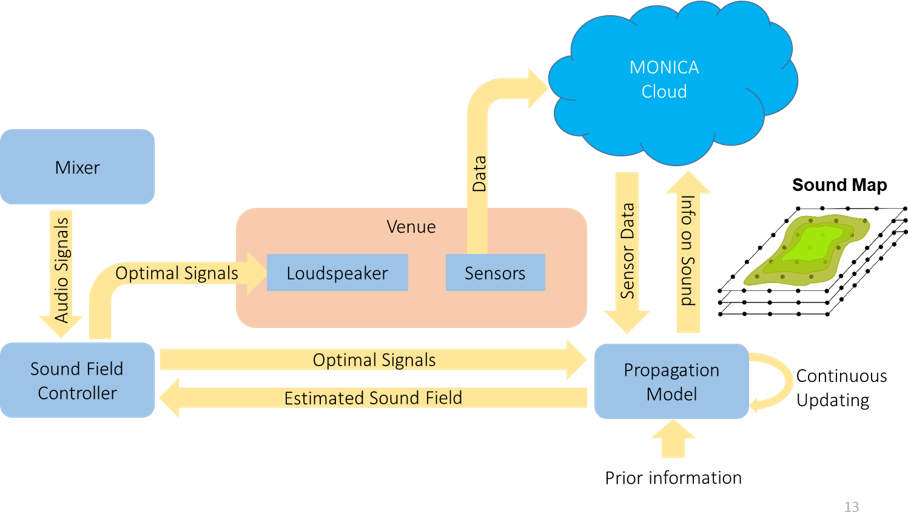
Concept of the ASFC (Adaptive Sound Field Control) system
For developers:
🛠 The Sound Field Controller
🛠 Results from AFSC tests
🛠 Audio wiring for the AFSC
The MONICA Adaptive Sound Field Control solution can be divided into six parts:
- The Adaptive Sound Field Controller drives the secondary source loudspeaker array by feeding the organizer’s Public Address (PA) system into an acoustic closed loop system.
- A Sound Propagation Module uses environmental data to estimate the transfer-functions between sound sources and the control areas, which are needed by the Adaptive Sound Field Controller’s optimization routine.
- The Sound Heat Map calculates an estimation of how the sound is propagating through a concert venue. A Sound Heat Map can be a coarser prediction for visual inspection or informative assessment.
- Sound Level Meters are used to measure sound levels at strategic locations and send the information to the Sound Heat Map as well as to sound technicians and possible to external stakeholders such as public authorities, the audience, and the neighbourhood.
- A secondary source Loudspeaker Array System is placed behind the audience between the primary sources and the neighbouring region in which the sound from the event should be reduced (dark zone).
- A Quiet Zone is a small localised noise barrier, which creates the highest possible attenuation of noise across the whole listening spectrum so that event staff can speak together in the middle of the concert area.
Adaptive Sound Field Controller: The ASFC system receives audio signals from the concert’s PA console or from behind the PA’s power amplifiers. The latter would be the primary choice because the standard PA system incorporates signal processing units into the power amplification stage. For example, devices such as limiters cause nonlinear components which will decrease the performance of the Adaptive Sound Field Controller. The audio signals, that are needed to feed to an Adaptive Sound Field Controller algorithm, will be the “reference” signal. In all the pilot demonstrations, reference signals were either obtained from the console (mixer) or from a signal “sniffer” device (inserted between power amplifier and speaker channel). Good results were obtained with both methods.
The infrastructure of the Adaptive Sound Field Controller consists of signal gateway/router (signal monitoring and control of main PA system), hub (audio interface), ASFC Core (Digital Signal Processor – DSP), and loudspeaker system (multichannel amplifier and loudspeakers). The ASFC Core calculates the optimal solution based on a sound propagation model estimation. Multichannel signal rendering (filtering) may be processed using a general desktop PC but can be developed as a stand-alone DSP for more efficient computing.
A well performing ASFC system will enable a high sound pressure level (SPL) in the bright zone relative to the sound pressure level in the dark zone. A performance indicator for this reduction in SPL is the insertion loss (IL), i.e. the reduction in decibels provided by the ASFC system within the dark zone compared to the bright zone. With the MONICA Adaptive Sound Field Control solution, the demonstration pilots have obtained up to 10dB reduction in the low frequency band at the various demonstration sites.
Sound propagation model: Sound field control in outdoor spaces requires accurate estimates of the transfer functions between source and receiver. Feedforward approaches are based on direct measurements of the transfer functions in a dense grid of points. However, this makes them intractable for large-scale situations. Hence there is a need for propagation models to characterize the sound field in large areas and provide the ASFC system with such proper transfer functions.
During the first year, the MONICA project investigated the adequateness of Nord2000. The Nord2000 specifies a calculation method for the prediction of the attenuation of sound during propagation outdoors. However, it turned out to have severe limitations when modelling sound propagation at low frequencies and titled to further research and development of alternatives.
During the second year, a new model based on spherical harmonics was successfully tested under controlled conditions in the anechoic chamber for a scaled setup of 2 x 5 m. The acoustic contrast produced when using this model is very similar to the one that can be obtained using a dense grid of microphones.
In the next phase, a novel Source Separation/Contribution technique was introduced in order to improve the estimation capability of the sound propagation model. The aim of this technique is to estimate the amount of noise contribution (in sound pressure level in dB over time, or similar) that originates from the actual concert in the presence of background noise created from other noise sources (such as traffic noise, people talking, etc.). The technique thus answers the question: Is the noise coming from the concert or from other sources, and if this is coming from the venue, what is the contribution from the venue. The Contribution technique was successfully demonstrated at the Sound2019 in Roskilde and may be used for future sound propagation models.
Sound Heat Map: The Sound Heat Map provides an estimate of the SPL at other positions than the one being measured by a Sound Level Meter. The forward sound propagation model calculates an estimation of how the sound is propagating throughout a well-defined area. The forward sound propagation model can be used the calculation of the EU noise indicators Lden and Lnight, in addition to the production of Sound Heat Maps.
The. Sound Heat Map can be used as a stan-alone solution or as part of the ASFC system. The difference is that the ASFC needs very precise predictions on how the sound propagates, while the Sound Heat Map can provide coarser prediction to be used for visual inspection or informative assessment.
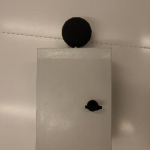
IoT Enabled SLM
Sound Level Meters: The transfer-function measurements can be been conducted with standard wired microphones. However, at the concert venues, where the dark zones are far away from the stage and ASFC system, it is recommended to use the MONICA IoT enabled Sound Level Meters described in the MONICA Crowd and Capacity Monitoring solution.
Loudspeaker Array Systems: The PA amplifier output signal is fed into the ASFC system
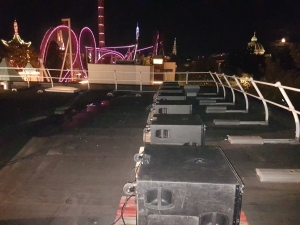
AFCS secondary source loudspeakers on roof of Tivoli Concert Hall 2018
aas a reference signal. For real-time application, the music signal, or “sniffer output”, has to be convolved in real-time with the Finite Impulse Response (FIR) filters for each control loudspeaker. A sniffer device for converting the loudspeaker amplifier output signal to line levels has been developed. The loudspeaker systems (secondary sources) are extended by the use of additional low-frequency loudspeakers. The secondary source loudspeakers are placed behind the audience between the primary sources and the neighbouring region where the event sound should be reduced (dark zone). It is important, that the secondary source loudspeakers do not negatively impact the sound experience in the bright zone. This restriction must be taken into account in the loudspeaker configuration by using either directive loudspeakers facing away from the bright zone or in the formulation of the loudspeaker signal optimization problem.
Quiet Zone: The principle of the Quiet Zone is to make use of a) the ASFC to cancel out low frequencies and passive elements (sound blocking screens) and b) to block higher frequencies using a passive noise barrier. The aim is to obtain the highest possible attenuation of sound level across the entire listening spectrum without disturbing the sound field from the primary sources. The active part of the Quiet Zone system consists of arrays of loudspeakers that synthesize the cancelling sound-field to cancel out the noise-field in the desired zone. In simulations, different aspects of the design of the Quiet Zone system have been investigated.
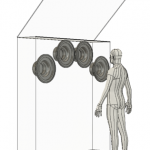
Quiet Zone Visualisation
A Quiet Zone, which is quiet in a defined area but introduces noise into the surrounding, lacks meaning. The design is constrained by practicalities, costs and its impact on the surroundings, which means that unwanted acoustic energy could be emitted by the Quiet Zone system itself.
The positioning of the secondary sources is e.g. limited by the dimensions of the speakers – which means they can’t be put very close to each other. On the other hand, having them far away from each other would just be impractical. The number of speakers and microphones should be as low as possible in order to minimize the costs. As a result of the simulations, the following can be recommended:
- A distance of about 1.5 to 2m to the secondary sources is recommended, which is also practical for the physical implementation of the system.
- The optimal distance between the secondary source speakers is about 1-1.2m. A deviation from this optimum does not have a big impact on the attenuation.
The number of secondary sources has a big impact on the costs of a quiet zone system. The number of speakers also depends on the frequency range of interest. For frequencies up to 200 Hz more than three speakers do not have a significant impact. For frequencies up to 500 Hz more than 5 speakers only result in a marginal increase of attenuation.
A passive noise barrier is added in front of the secondary source loudspeaker to block higher frequencies. However, the existence of the passive element might introduce problems into the active part.
ASFC communication: The ASFC Core does not require the connection to MONICA Cloud. It can function as a stand-alone system. However, single or multiple PCs computing the sound propagation model and the sound field optimization algorithm, and rendering multi-channel signal outputs require good, stable communication connections within the system. necessitates a stable network that can transfer a relatively high rate of data (minimum 1 Mbit/sec is required).
SLM communication: A stable connection to the 10-15 SLM in the area is crucial for the performance of the ASFC system. The most stable solution is the use of a cabled connection to all SLMs. However, this requires massive cabling throughout the venue, which can be costly and unsafe. A WiFi or 3G/4G network can be a substitute method but high stability is required to avoid data loss and high bandwidth for advanced functionalities. For the IoT SLM, WiFi-connection mode has been updated with special firmware, which dramatically improves the connectivity. Another possible issue could be the clock synchronization between the SLM and the ASFC system’s D/A converters. To ensure accurate transfer-function measurements, future SLMs will feature an alternative protocol that can perform time synchronisation over long distances. However, limitations may arise depending on general WiFi network traffic at the site. SLMs can also use 4G where there is no WiFi available.
The MONICA Adaptive Sound Field Control solution is a complex solution that relies on both external components and technologies as well as components, enablers, and tools from the MONICA project partners. Please contact the responsible partners listed below for more information.
The ASFC system interacts with the MONICA IoT platform in two ways:
- The MONICA platform provides various collected sensor data (e.g. weather conditions and sound pressure) to the ASFC system upon requests, which is used to update the sound propagation model and estimate the sound propagation in and around the venue.
- The sound propagation model supplies information on the sound condition in and around the venue to the MONICA Cloud in the form of a Sound Heat Map.
External technologies required
Additional to the venue’s sound-system the following major equipment is needed in order to run the Adaptive Sound Field Controller:
Secondary source loudspeaker system: High power multiple loudspeaker, Amplifier system (type/brand should match the venues system), multi-channel DAC (RME M-32 DA (x2) or equivalent), cabling and rigging equipment.
Sound monitor system: Monitors the signal output of venue’s PA system (RME MADI Router or equivalent), multi-channel ADC (RME M-32 AD or equivalent).
Internal MONICA enablers and tools required
None
Scalability
Scalability is an issue. Control over large areas needs considerate amount of control loudspeakers and microphones. Every installation is different and scalability issues will be determined in the initial site-survey and feasibility study.
Associated MONICA solutions
The MONICA Adaptive Sound Field Control is closely related to and have been demonstrated together with these additional MONICA solutions:
- MONICA Sound Level Monitoring
- MONICA Crowd and Capacity Monitoring
- MONICA Crowd Management and Communication (including cloud server and COP)
The MONICA Adaptive Sound Field Control cannot be implemented as a customer-specific solution independent of other MONICA solutions.
Implementation
Preparation
For the best performance of the ASFC system, the following preparations should be carefully executed and venue specific information needs to be communicated with ASFC specialists.
Information required:
- Detailed geometrical plans or drawings of the venue and its surroundings for the sound propagation model. Preferred in digital format. Information about surface materials can also be used. Elevation of the terrain (Digital Elevation Models).
- It is necessary to choose possible positions for microphones, weather sensors, additional speakers.
- The signal chain of a venue’s PA system with EQ, delay line information, loudspeaker configuration.
- Definition from the client of the most critical areas in the neighbourhood and the less important ones, so to tune the system to reduce the sound in the problematic areas.
- The following roles should be contacted in the preparation phase: responsible for sound from the venue, sound engineers of bands playing, responsible for band booking, renting/equipment company.
Deployment
The MONICA partner can provide a system integration package including site survey, design and planning, installation, test, and operational support during the event.
Before the event: The venue’s model needs to be integrated into the sound propagation model and the development of possible setups regarding the placement of loudspeakers and sensors needs to be done.
The final primary and secondary sound system design is developed together with a sound system designer/engineer of the venue.
During the event setup: Installation/Setup and conventional tuning of PA system: This tuning presents the fall-back state (if something goes wrong) and cannot be changed without impacting the tuning of the ASFC system. Tuning/Initialization of ASFC system: This will involve the measurement of transfer-functions between the single channels of the PA and the control areas (listening area and neighbouring area). It also involves doing measurements to estimate the ‘static’ model parameters.
Operation
The functionality should be continuously checked during the concert by measurements and/or human listening.
The operational status of the system can only be evaluated indirectly. The active noise controller is running under heavy computational cost and robust performance is needed to avoid audible dropout. The calculation of the performance measure insertion loss (IL) in real-time and on the same machine would have added the risk of dropouts.
The performance can otherwise be roughly evaluated through the real-time metering of the sound pressure levels in the error microphones. This is a rough estimate because the sound level meters show a broadband signal, while the active noise controller acts on low frequencies only. A quantitative estimate of the performance in real-time is the insertion loss suggested. IL is directly related to the amount of sound pressure per frequency that is attenuated by the system. Such a measure could be estimated on a parallel computer and presented as a time-varying frequency spectrum on a screen or sent to the COP.
Reproducibility means that a MONICA solution (including data sets, software code, etc) can be made available to others for reproducing the same results.
No reproducibility data sets are available for the MONICA Adaptive Sound Field Control solution.
Technical regulations
- The analysis in the MONICA IoT Sound Level Meter conforms to the international standard IEC 61672-1 (Class 1) and has implemented frequency and time weightings as specified in the standard.
- The MONICA IoT Sound Level Meter conforms to the international standard IEC 61260-1 and has implemented 1/1-octave and 1/3-octave frequency analyses as specified in the standard.
- Sound Level Meters and Gateways comply with the Radio Equipment Directive 2014/53/EU (RED).
- Authentication for data transfer is enabled using OAuth 2.0, the industry-standard protocol for authorization.
- The hardware must comply with the Waste Electrical and Electronic Equipment Directive (WEEE 2012/19/EU).
- The hardware must be marked with the WEEE mark.
- The hardware contains electronic equipment and the supplier and the organiser must agree on the proper take-back procedure for the used hardware.
- The hardware must comply with the Restriction of Hazardous Substances in Electrical and Electronic Equipment Directive (RoHS 2011/65/EU).
Other local/national regulations
There are no personal data captured or handled in the MONICA Adaptive Sound Field solution. Hence, the GDPR regulation does not apply to this solution.
Ethics
There are no ethical concerns associated with the use of the MONICA Adaptive Sound Field Solution. However, the use of CCTV cameras for determining the density of the audience (as used in the propagation models) may raise concerns about increased surveillance practices and how these affect citizens’ rights to privacy.
Lesson Learned has been collected throughout the deployment and demonstration phases of the MONICA project and the relevant Lesson Learned are provided here for reference. Please check with the responsible partner for the newest updates.
The following main Lesson Learned from the MONICA demonstrations and reference deployments are:
- The AFSC system works well in open terrain, but cannot be expected to give similar reductions in a city environment.
- For thorough and complete testing of the ASFC system, it is essential to have a dedicated 4-hours timeslot without interruptions
- The system must be calibrated prior to the event to establish references values.
- Weather conditions may impact measurements. For instance, the wind might propagate noise very far from a venue. The reference values will help to discriminate against other sound sources during the event, calculate the weather effect, set up the sound system according to the local regulations and prepare the tuning of the ASFC system.
Replication
Business Models
The Business Model Canvas is used to give a high-level overview of the contents in the value configuration and in the customer group side related to a specific value proposition. This tool is used to map out all details of the MONICA business models based on the value proposition, target groups, the partner constellations, and revenue models outlined below.
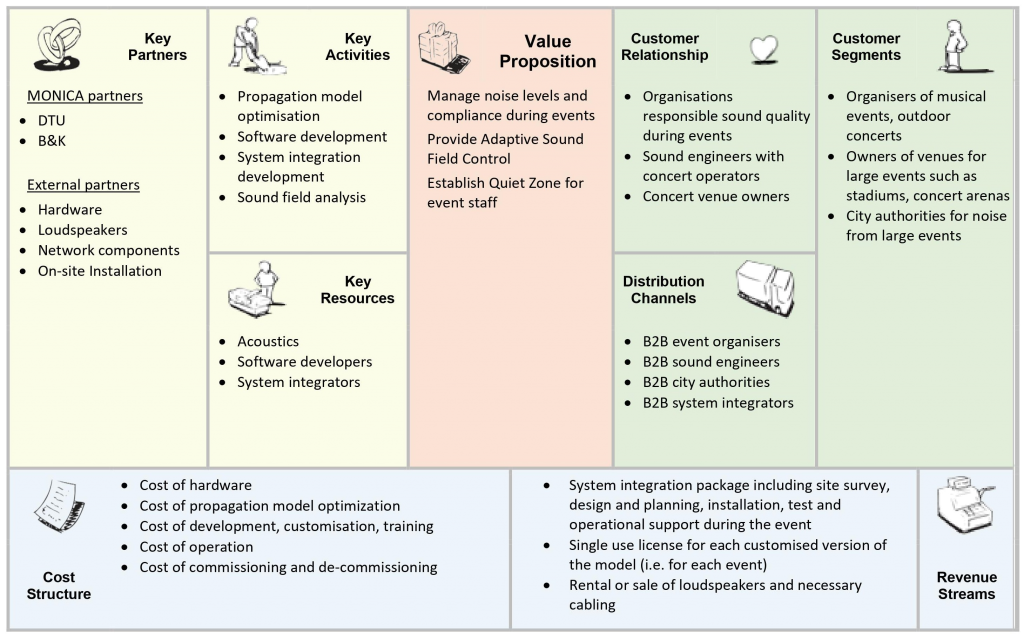
Business Model Canvas for the MONICA Adaptive Sound Field Control solution © In-JeT ApS
Revenue models
The choice of revenue model and pricing scheme is entirely up to the partner that have commercialised the solutions. Hence, the following information is solely provided as a guide to the expected business conditions that the solutions might be provided at. Please contact the responsible partner for further, up-to-date details.
| Solution | Type | Anticipated revenue model |
|---|---|---|
| Adaptive Sound Field Controller | Software, Hardware, Services, Customisation | Provided as a system integration package including site survey, design and planning, installation, test and operational support during the event |
| Sound propagation model | Software, Algorithms | Supplied as a single use license for each customised version of the model (i.e. for each event) |
| Sound Heat Map | Software, Algorithms | Supplied as a single use license for each customised version of the model (i.e. for each event) |
| Loudspeaker Array System | Hardware | Provided as rental or purchase of loudspeakers and necessary cabling |
| Quiet Zone | Hardware, Software, Services | Provided as a system integration package including site survey, design and planning, installation, test and operational support during the event |
Reference deployments
During the project period 2017 – 2020, the MONICA Adaptive Sound Field Control solution was deployed and tested in real-life situations during planned pilot events. Validated results from these reference implementations can be found in D9.2 Final Assessment and Validation Report of the MONICA IoT Platform. Follow the links below to read articles about the demonstrations.
| MONICA demonstration events | |
|---|---|
| Tivoli |
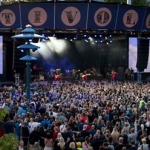 Tivoli Fredagsrock 2018 |
Città di Torino
|
 Kappa FuturFestival 18 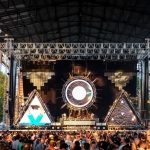 Kappa FuturFestival 19 |
For more information, please see the contact list below
Replicators
During the project, the MONICA Adaptive Sound Field Control solution was deployed and tested in real-life situations in events outside the planned MONICA demonstrations. These events were suggested by external partners due to their interest in the MONICA solutions. Please contact the organisers for further information.
| MONICA Replication events | |
|---|---|
Roskilde
|
 Sound2019, Roskilde |
The following partners are responsible for various components of the MONICA Adaptive Sound Field Control solution:
| Solution | Responsible | Acronym | Details |
|---|---|---|---|
| Adaptive Sound Field Controller | Technical University of Denmark | DTU | DTU offers a total system integration package including site survey, design and planning, installation, test and operational support during the event |
| Sound propagation model | Technical University of Denmark | DTU | DTU offers to deliver, customise and train the sound propagation model for the ASFC system |
| Sound Heat Map | Technical University of Denmark | DTU | DTU offers to deliver, customise and adapt the noise heat map for the ASFC system |
| Sound Level Meters | Brüel & Kjær | B&K | B&K can supply a variety of accredited SLM |
| Loudspeaker Array System | Technical University of Denmark | DTU | DTU offers advice on the purchase or rental of loudspeakers for the ASFC system |
| Quiet Zone | Technical University of Denmark | DTU | DTU offers to deliver, customise and test the Quiet Zone for use with an existing ASFC system |


